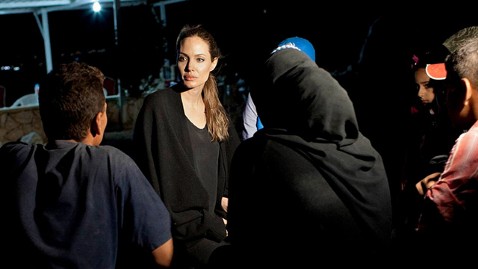Angelina Jolie Visits Syrian Refugee Camp

J. Tanner /UNHCR/AP Photo
JERUSALEM - The world's most famous advocate for refugees visited Jordan's dusty and fast-growing Zaatari refugee camp for Syrians today, describing it as "a horrific situation and a very, very critical time."
Oscar-winning actress Angelina Jolie, in her role as special envoy for the United Nations Refugee Agency, toured the camp near the Syrian border that is now home almost 30,000 refugees.
"I am very concerned, the world is very concerned," Jolie said, according to the Associated Press, her eyes brimming with emotion. "What is very heartbreaking is when Syrian people ask you why you think no one is able to find a solution for them."
Jolie walked around the camp with top U.N. refugee official Antonio Guterres and Jordanian Foreign Minister Nasser Judeh. The AP reported that she met separately with women in the camp.
"When you meet so many innocent people and civilians, the people of Syria are asking who is on their side. `Who is going to help us as the months go on?"' she said.
The U.N. has registered a quarter of a million refugees who have fled the violence of Syria's 18-month conflict. But the actual number of refugees crossing into neighboring Turkey, Lebanon, Iraq and Jordan is far higher as many don't register, going instead to stay with family and friends, melting into border towns or going farther afield.
There are around 28,000 refugees at Zaatari, though Jordan has taken in some 200,000, according to Guterres. The camp grows by about 1,000 refugees every day, most crossing at night to avoid detection by Syrian troops near the border.
"At present we're trying to cope with what we have, but we also need additional assistance," UNHCR coordinator Karen Whiting told ABC News the day before Jolie's visit. "Additional funds, and then also additional agencies to come and assist us to help provide protection and assistance to the refugees."
"The major priority right now is to ensure that we're ready for the winter which means that we need to take actions right away to ensure that [the refugees] are protected from the elements and that they're in conditions of safety and dignity," she said.
Row upon row of white UNHCR tents are lined up in the sprawling camp in the middle of the desert, the paths between them made up of rocks and powdery sand. As the sun raises temperatures to around 100 degrees Fahrenheit during the day, the wind lifts huge clouds of sand, sending it across the camp and coating everything with a layer of brown dust.
Even as the Jordanian government and aid agencies insist they are doing everything to make the refugees comfortable, many complain about the conditions, especially the swirling dust.
"There's no milk," said Moaz Hassan Bikai, 20, as he cradled his sleeping 8-month old niece. Others gathering around complained of "rotten food" and non-potable water. Many said they would rather be back in Syria than live in the harsh conditions.
Guterres agreed today that the conditions are "still not acceptable" and called for "massive international funding." The head of the U.S. Agency for International Development, Dr. Rajiv Shah, visited Zaatari last week, promising an additional $21 million in aid.
As vans drove among the tents handing out boxed meals, representatives from Save the Children walked outside the tents with a megaphone, calling on parents to register their children for school. Many have not been inside a classroom since the conflict began a year and a half ago.
Zaatari's maximum capacity is 80,000 refugees and with more than 100,000 expected before the end of the year, one or two more camps are expected to be built soon nearby.
"We have to be prepared," said Whiting. "At present the situation would indicate that we'll be here for a while."